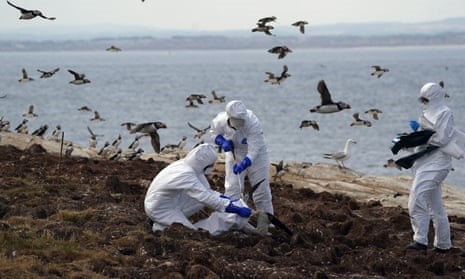Description

Disclaimer: Copyright infringement not intended.
Context:
- A bird flu outbreak on a Spanish mink farm has alarmed scientists. The virus may be spreading for the first time from mammal to mammal — and could become a danger for humans.
What is Bird Flu?
- Bird flu or avian influenza is a disease caused by avian influenza Type A virusesfound naturally in wild birds worldwide.
- The virus infects domestic poultry including chickens, ducks, turkeys and there have been reports of H5N1 infection among pigs, cats, and even tigers in Thailand zoos.
- Avian Influenza type A viruses are classified based on two proteins on their surfaces – Hemagglutinin(HA) and Neuraminidase(NA).
- There are about 18 HA subtypes and 11 NA subtypes. Several combinations of these two proteins are possible e.g., H5N1, H7N2, H9N6, H17N10, etc.
.jpeg)
Bird flu: Infection in Humans:
- There have been reports of avian and swine influenza infections in humans including A(H1N1), A(H1N2), A(H5N1), A(H7N9), etc.
- The first report of human H5N1 infection was in 1997 and currently, over 700 human cases of Asian Highly Pathogenic Asian Avian Influenza A (HPAI) H5N1 virus have been reported to the World Health Organisation from 16 countries.
- The infection is deadly as it has a high mortality rate of about 60%.
- The most common route of virus transmission is direct contact— when a person comes in close contact with infected birds, either dead or alive.
- Humans can also be affected if they come in contact with contaminated surfaces or air near the infected poultry.
- There is no sufficient evidence suggesting the spread of the virus through properly cooked meat.
Symptoms of Avian Influenza:
- Fever, cough, sore throat, muscle aches, nausea, abdominal pain, diarrhea, vomiting
- Severe respiratory illness
- Neurologic changes (altered mental status, seizures)
Risk groups:
- Children and adults below 40 were seen to be the most affected and mortality was high in 10-19 years olds.
Bird flu: Human-to-Human Transmission:
- The transmission of the virus from birds to humans is rare and sustained human-to-human transmission of the H5N1 virus has not yet been established.
- But then people working closely with poultry must take precautionary measures and maintain proper personal hygiene.
- Although a few isolated family clusters have been reported, transmission in these clusters may have occurred through common exposure and in rare situations a very close physical contact; there is no evidence of human-to-human transmission via small-particle aerosols.

The recent outbreak:
- A bird flu outbreak on a Spanish mink farm has alarmed scientists. The virus may be spreading for the first time from mammal to mammal — and could become a danger for humans.
Why is the mink farm outbreak ‘incredibly concerning’?
- The spread of the virus from birds to other species is nothing new. The pathogen that causes bird flu, or avian influenza, has been found in raccoons, foxes and seals, though these remain isolated cases.
- While there have been some cases of H5N1 infecting humans, the World Health Organization has said there’s no evidence of human-to-human transmission so far.
- When the disease has spread to humans and other mammals, it has been via direct contact with excrement from infected birds or their carcasses.
- But the mink outbreak appears to be a rare case where mammals are transmitting the disease to each other rather than through direct contact with an infected bird. This is something “new.
- Part of the problem is that mink are intensively farmed. They’re kept in high numbers in confined spaces, which means infection spreads rapidly in the highly susceptible mammals.
- Researchers have identified several pathogen mutations in the mink, one of which allows “the virus to better reproduce in mammals.
- Scientists are worried that the virus, which has led to the deaths of tens of millions of birds globally, could spread to more mink farms and become “more transmissible.”
Could avian influenza trigger a human pandemic?
- Of the 868 known cases of H5N1 infection in humans worldwide between January 2003 and November 2022, 457 were fatal, according to the WHO.
- However, because there has been no sustained human-to-human transmission, the risk of human infection from avian flu is low.


https://indianexpress.com/article/explained/explained-health/scientists-concerned-spread-of-bird-flu-to-mink-signals-growing-threat-to-human















